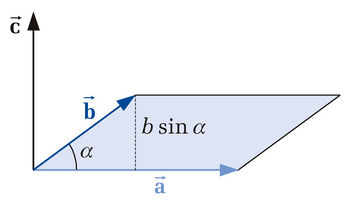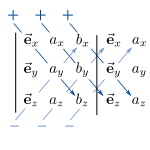Cross product
| ← Back: Dot product | Overview: Vector algebra | Next: Matrices → |
The cross product of two vectors is denoted with an  . The cross product of vector
. The cross product of vector  and vector
and vector  results in a new vector
results in a new vector
that is perpendicular to the surface spanned by vectors  and
and  (see figure). Furthermore the three vectors
(see figure). Furthermore the three vectors  ,
,  and
and  build a rectangular coordinate system based on the right-hand rule. The magnitude of vector
build a rectangular coordinate system based on the right-hand rule. The magnitude of vector  equals the area of the parallelogram spanned by
equals the area of the parallelogram spanned by  and
and  and is calculated as follows:
and is calculated as follows:
Dabei bezeichnet  den Winkel, der von den beiden Vektoren eingeschlossen wird und Werte zwischen
den Winkel, der von den beiden Vektoren eingeschlossen wird und Werte zwischen  und
und  annehmen kann (siehe Abbildung). Weiterhin gilt es zu beachten, dass das Vektorprodukt ausschließlich für den dreidimensionalen euklidischen Vektorraum definiert ist. Rechnerisch gilt der folgende Zusammenhang:
annehmen kann (siehe Abbildung). Weiterhin gilt es zu beachten, dass das Vektorprodukt ausschließlich für den dreidimensionalen euklidischen Vektorraum definiert ist. Rechnerisch gilt der folgende Zusammenhang:
Als Merkhilfe für diesen Zusammenhang eignet sich die Regel von Sarrus: Entsprechend der Abbildung werden dabei die Einheitsvektoren des kartesischen Koordinatensystems in eine erste Spalte und die anderen beiden Vektoren in eine zweite und dritte Spalte geschrieben. Auf diese Weise erhält man eine Matrix, deren ersten beiden Spalten nun erneut rechts neben diese Matrix geschrieben werden. Nun führt man die Multiplikationen und Additionen wie in der Abbildung gezeigt aus und erhält:
Aus mathematischer Sicht bestimmt man auf diese Weise die Determinante der genannten Matrix. Anhand der beschriebenen Zusammenhänge zeigt sich, dass das Skalarprodukt nicht dem Kommutativgesetz genügt. Stattdessen gilt:
Weiterhin ergeben sich einige Sonderfälle, die im technischen Kontext häufig zu Vereinfachungen führen:
 <br/<
<br/<
Multimedial educational material
|
http://www.surendranath.org/Applets/Math/VectorProduct/VP.html Applet: Cross product of two vectors in cartesian and polar coordinates http://demonstrations.wolfram.com/CrossProductOfVectorsInTheYZPlane/ Applet: Cross product of two vectors in the yz-plane |
Literatur
- Manfred Albach, Grundlagen der Elektrotechnik 1: Erfahrungssätze, Bauelemente, Gleichstromschaltungen, 3. Edition (Pearson Studium, 2011)
- Kurt Meyberg und Peter Vachenauer, Höhere Mathematik 1: Differential- und Integralrechnung. Vektor- und Matrizenrechnung, 6. Edition (Springer Berlin Heidelberg, 2001)
- Wolfgang Pavel und Ralf Winkler, Mathematik für Naturwissenschaftler, 1. Edition (Pearson Studium, 2007)







